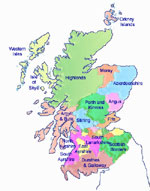|
|
Welcome to Killin Scotland
 Killin
is a village situated at the western head of Loch Tay in Stirling (formerly
Perthshire), Scotland. Killin
is a village situated at the western head of Loch Tay in Stirling (formerly
Perthshire), Scotland.
The west end of the village is magnificently sited around the scenic
Falls of Dochart, the main street leading down towards the Loch at the
confluence of the rivers Dochart and Lochay. The Falls are crossed by
a narrow, multi-arched stone bridge carrying the main A827 road into Killin.
The MacNab Clan were once dominant here, and have long been associated
with Killin. Their ancient burial ground is on Inchbuie in the River Dochart,
just below the Falls, and is visible from the bridge.
Kinnell House was the seat of the MacNabs. A well preserved prehistoric
standing stone circle (possibly 'restored' to improve its appearance)
can be seen in the grounds of the House. To the north of the village lie
the ruins of the Campbells of Breadalbane stronghold of Finlarig Castle,
with its associated chapel. The growing power of the Campbells eventually
ousted the MacNabs, who lost Kinnell House to their rivals. In 1694 Sir
John Campbell of Glenorchy, 1st Earl of Breadalbane established Killin
as a Burgh of barony.
 By the end of
the 18th century there was a local linen industry. Flax was grown locally,
spun in small mills and woven into linen by home based weavers. Today,
Killin services the local rural community and the growing tourism and
leisure industries. In addition to walking on Ben Lawers, fishing for
trout and salmon there are various watersports available on Loch Tay.
Many local vernacular buildings have been preserved or converted, allowing
the village to retain much of its historic character. By the end of
the 18th century there was a local linen industry. Flax was grown locally,
spun in small mills and woven into linen by home based weavers. Today,
Killin services the local rural community and the growing tourism and
leisure industries. In addition to walking on Ben Lawers, fishing for
trout and salmon there are various watersports available on Loch Tay.
Many local vernacular buildings have been preserved or converted, allowing
the village to retain much of its historic character.
The 19th century Moirlanich Longhouse in nearby Glen Lochay is a rare
surviving example of the cruck frame Scottish longhouse, and is now in
the care of the National Trust for Scotland. The Breadalbane Folklore
Centre in the Victorian former village mill displays the 'healing stones'
of Saint Fillan.
Tomnadashan Mine, an abandoned copper mine overlooking the village, is
sometimes identified as the haunt of the Rabbit of Caerbannog of Monty
Python and the Holy Grail fame.
Accommodation in and around Killin
Price Guide - per person based on sharing room:  under $40 -
under $40 -  $41
- 70 - $41
- 70 -  more than
$70 more than
$70
|
![]() Email enquiries & reservations: bookscotland@madbookings.com
Email enquiries & reservations: bookscotland@madbookings.com
 Killin
is a village situated at the western head of Loch Tay in Stirling (formerly
Perthshire), Scotland.
Killin
is a village situated at the western head of Loch Tay in Stirling (formerly
Perthshire), Scotland. By the end of
the 18th century there was a local linen industry. Flax was grown locally,
spun in small mills and woven into linen by home based weavers. Today,
Killin services the local rural community and the growing tourism and
leisure industries. In addition to walking on Ben Lawers, fishing for
trout and salmon there are various watersports available on Loch Tay.
Many local vernacular buildings have been preserved or converted, allowing
the village to retain much of its historic character.
By the end of
the 18th century there was a local linen industry. Flax was grown locally,
spun in small mills and woven into linen by home based weavers. Today,
Killin services the local rural community and the growing tourism and
leisure industries. In addition to walking on Ben Lawers, fishing for
trout and salmon there are various watersports available on Loch Tay.
Many local vernacular buildings have been preserved or converted, allowing
the village to retain much of its historic character.

















